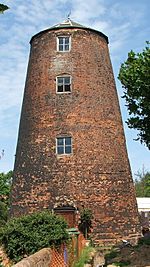Blundeston Windmill facts for kids
Quick facts for kids Blundeston Windmill |
|
|---|---|

The mill in June 2011
|
|
| Origin | |
| Mill name | Blundeston Mill |
| Grid reference | TM 5165 9747 |
| Coordinates | 52°31′00″N 1°42′26″E / 52.51676°N 1.70734°E |
| Operator(s) | Private |
| Year built | c1820 |
| Information | |
| Purpose | Corn mill |
| Type | Tower mill |
| Storeys | Four storeys |
| No. of sails | Four Sails |
| Type of sails | Patent sails |
| Winding | Fantail |
| No. of pairs of millstones | Two pairs |
Blundeston Mill is a historic windmill located in Blundeston, Suffolk, England. This special building was once used to grind grain into flour. Today, it has been transformed into a unique home.
Contents
What is Blundeston Mill?
Blundeston Mill is a type of windmill called a tower mill. This means it has a tall, round stone or brick tower. Windmills use the power of the wind to turn large sails. These sails then power machinery inside the mill.
A Look Back: History of the Mill
When Was Blundeston Mill Built?
Blundeston Mill was built around 1820. A skilled craftsman named Robert Martin built it. He was a millwright from Beccles. A millwright is someone who designs, builds, or repairs mills.
How Long Did It Work?
The mill was busy grinding corn for over 100 years. It worked steadily until 1923. After that, it was no longer used for grinding.
From Mill to Home
In 1933, the mill was taken apart. Its machinery was removed. The tower was then converted into a house. This gave the old mill a new purpose.
How the Mill Worked
Mill Structure
Blundeston Mill has four main levels, or storeys. It was built as a strong tower. This design helped it stand tall against the wind.
The Sails
The mill had four large Patent sails. These sails were special because they could adjust themselves. This meant they could catch the wind better. They would open or close automatically, depending on how strong the wind was.
Turning into the Wind
The top part of the mill is called the cap. It was shaped like a boat. A special part called a fantail helped the cap turn. The fantail was a small set of blades at the back of the cap. As the wind blew, the fantail would spin. This spinning would slowly turn the entire cap. It made sure the main sails always faced the wind. This way, the mill could always catch the most wind power.
Grinding the Grain
Inside the mill, there were two pairs of millstones. These were large, heavy stones. The wind power from the sails turned these stones. Grain was fed between the spinning stones. The stones would grind the grain into flour. This flour was then used to make bread and other foods.

